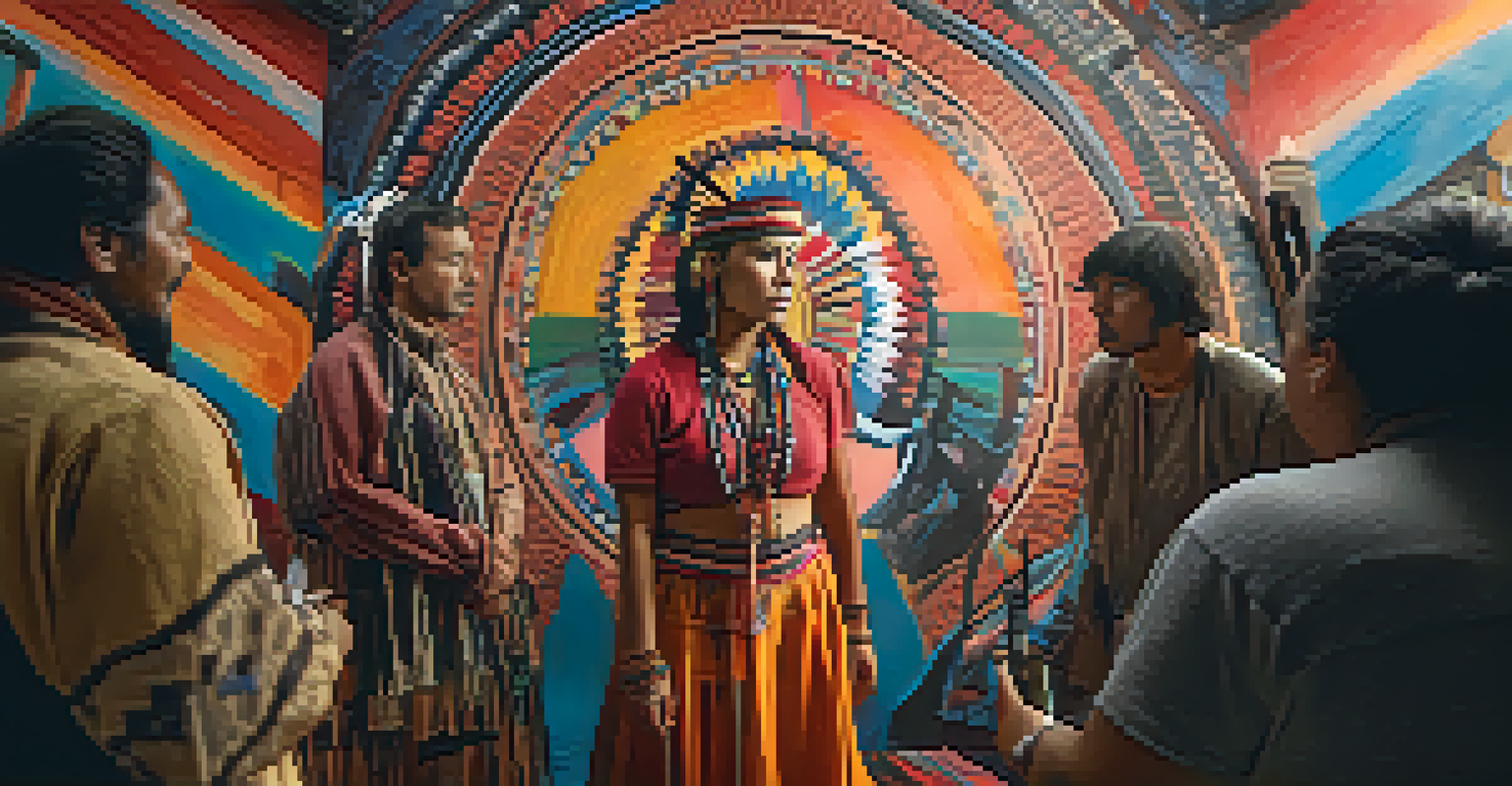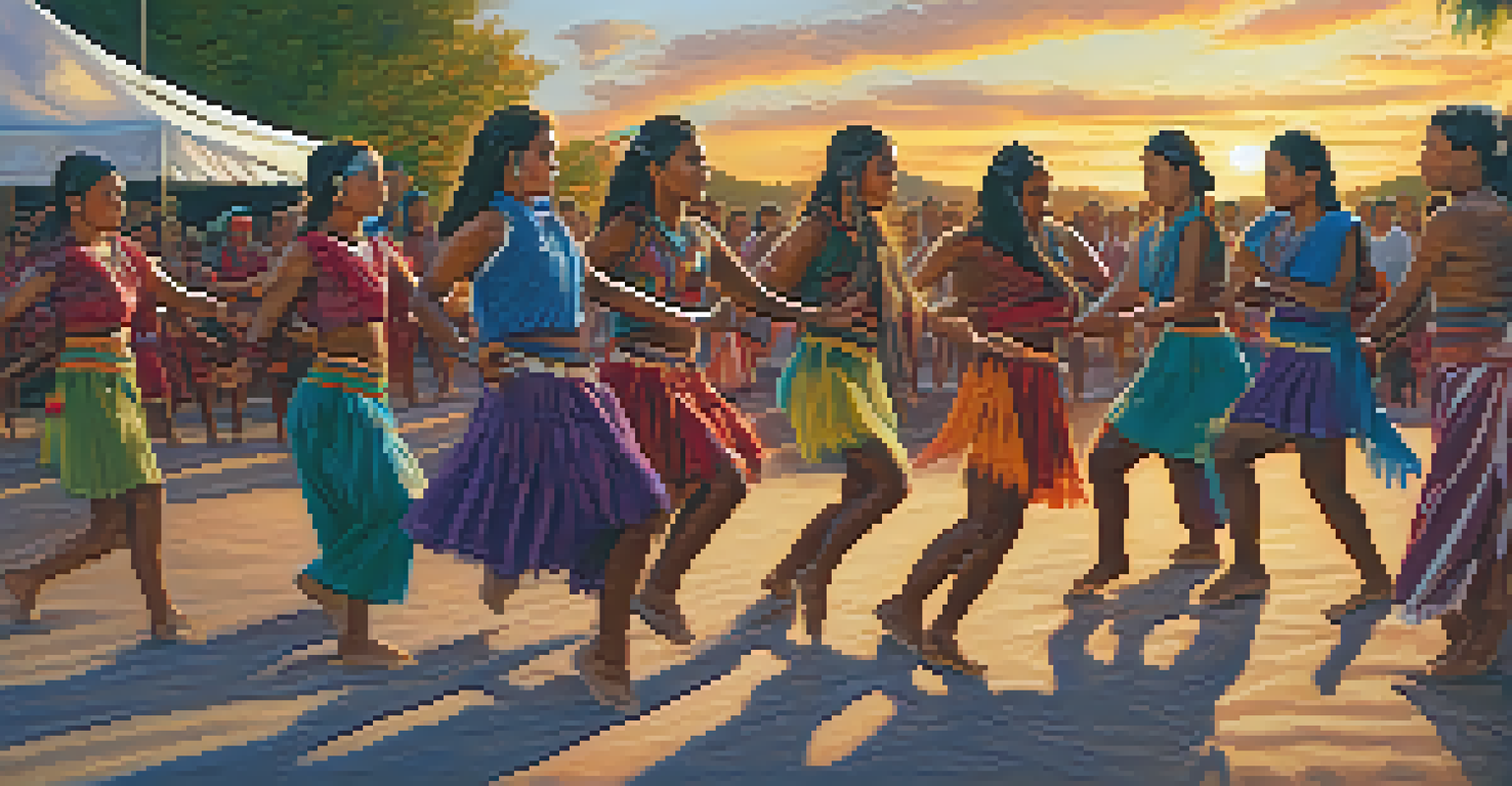Representation of Indigenous Cultures in Hollywood Films

Historical Misrepresentation of Indigenous Peoples
For decades, Hollywood has often misrepresented Indigenous cultures, portraying them through a narrow, simplistic lens. This led to stereotypes that painted Native Americans as either noble savages or ruthless warriors, failing to capture the rich diversity and complexity of their cultures. Such depictions not only misinform audiences but also contribute to the marginalization of Indigenous voices in society.
The stories of Indigenous peoples should be told by Indigenous peoples themselves, not through the lens of those who have historically marginalized them.
A prime example of this misrepresentation can be seen in classic Western films, where Indigenous people were frequently cast as antagonists. These portrayals not only reinforced harmful stereotypes but also ignored the real histories and narratives of Indigenous communities. As a result, many viewers grew up with a skewed perception of Indigenous cultures, one that lacked nuance and authenticity.
The impact of these portrayals extends beyond entertainment; they shape public perception and influence policy decisions. When Indigenous cultures are consistently depicted in a negative or inaccurate light, it perpetuates systemic issues, such as discrimination and cultural erasure. Therefore, recognizing and addressing these historical misrepresentations is crucial for fostering understanding and respect.
Shifts Towards Authentic Representation
In recent years, there has been a noticeable shift in how Hollywood approaches Indigenous representation. Filmmakers and producers are increasingly partnering with Indigenous consultants and communities to ensure authentic portrayals. This collaborative effort aims to present stories that reflect the true experiences and traditions of Indigenous peoples, moving away from one-dimensional stereotypes.

Films like 'Smoke Signals' and 'The Revenant' showcase Indigenous characters in more complex roles, depicting them as multidimensional individuals with their own narratives. These films not only provide a platform for Indigenous voices but also encourage audiences to engage with their stories in a meaningful way. By prioritizing authenticity, Hollywood can contribute to a richer understanding of Indigenous cultures.
Misrepresentation in Hollywood
Hollywood has historically portrayed Indigenous peoples through narrow stereotypes, which misinform audiences and marginalize their voices.
Moreover, the rise of Indigenous filmmakers has played a significant role in this change. Creators like Taika Waititi and Chloe Zhao are redefining the landscape by telling stories that resonate with their communities while appealing to broader audiences. Their success demonstrates that authentic representation not only enriches the film industry but also offers valuable insights into Indigenous cultures.
The Role of Indigenous Filmmakers
Indigenous filmmakers are crucial in paving the way for more authentic representations in Hollywood. By telling their own stories, they can challenge the mainstream narrative and offer fresh perspectives that resonate with both Indigenous and non-Indigenous audiences. This self-representation is vital in reclaiming cultural identity and agency in storytelling.
Representation matters; it shapes our perceptions, influences our understanding, and ultimately affects the policies that govern our lives.
For instance, films like 'Rhymes for Young Ghouls' and 'Mohawk' highlight Indigenous experiences from the creators' viewpoints, allowing for a deeper connection with the audience. These films often address contemporary issues faced by Indigenous communities, such as systemic racism and cultural preservation, making them relevant and relatable. This shift in narrative ownership is empowering for Indigenous peoples and helps dismantle stereotypes.
Additionally, Indigenous filmmakers often incorporate traditional storytelling techniques, blending them with modern cinematic styles. This fusion not only honors their cultural heritage but also makes their stories accessible to a wider audience. As more Indigenous voices enter the industry, the richness of these narratives continues to grow, fostering greater understanding and appreciation for diverse cultures.
Impact of Streaming Platforms on Representation
The rise of streaming platforms has significantly impacted how Indigenous cultures are portrayed in film and television. These platforms provide opportunities for diverse voices that traditional Hollywood may overlook. With more space for content, Indigenous stories can reach a global audience, breaking down barriers that once limited representation.
Shows like 'Reservation Dogs' have gained critical acclaim for their authentic depiction of Indigenous life, showcasing the talents and experiences of Indigenous creators. By prioritizing these narratives, streaming platforms are not only amplifying Indigenous voices but also reshaping the conversation around representation in media. This shift encourages audiences to engage with stories that reflect a more accurate and nuanced understanding of Indigenous cultures.
Authentic Representation Emerges
Recent shifts in Hollywood focus on authentic Indigenous representation, with filmmakers collaborating with Indigenous communities to tell more nuanced stories.
Moreover, the accessibility of streaming services allows for greater exploration of Indigenous issues and experiences. Viewers can discover films and series that might not have been available in traditional theaters, leading to a more enriching viewing experience. This democratization of content creates a space for dialogue and understanding, fostering a greater appreciation for the diversity within Indigenous communities.
Challenges Still Facing Indigenous Representation
Despite the positive changes in representation, challenges still persist for Indigenous peoples in Hollywood. Stereotypes and misconceptions continue to influence casting decisions and storytelling, often sidelining authentic Indigenous narratives. Additionally, many Indigenous actors and creators face barriers to entry in the film industry, limiting their ability to tell their own stories.
Moreover, the demand for more authentic representation can sometimes lead to tokenism, where Indigenous characters are included merely to fulfill diversity quotas. This approach undermines the significance of meaningful representation, as it does not address the underlying issues of systemic racism and cultural appropriation. True representation should involve collaboration and respect for Indigenous voices, ensuring their stories are told authentically.
Another significant challenge is the need for ongoing education and awareness. While progress has been made, audiences and industry professionals must actively engage in learning about Indigenous cultures and histories. This commitment to understanding can help dismantle harmful stereotypes and foster a more inclusive environment for Indigenous filmmakers and actors.
The Importance of Storytelling in Indigenous Cultures
Storytelling is a fundamental aspect of Indigenous cultures, serving as a means of preserving history, traditions, and values. Through oral traditions, Indigenous peoples have passed down knowledge from generation to generation, ensuring the survival of their cultural identities. This rich heritage emphasizes the importance of representation in film, as it allows these stories to reach broader audiences.
Incorporating Indigenous storytelling techniques in films can enhance the authenticity and depth of narratives. By weaving in cultural elements and perspectives, filmmakers can create a more immersive experience that resonates with viewers. This approach not only honors Indigenous cultures but also enriches the cinematic landscape by introducing new storytelling methods.
Challenges Remain in Storytelling
Despite progress, challenges such as tokenism and ongoing stereotypes still hinder authentic representation and storytelling in the film industry.
Furthermore, storytelling can serve as a powerful tool for healing and reconciliation. By sharing their experiences and narratives, Indigenous peoples can foster understanding and empathy among audiences. This dialogue is essential for bridging cultural divides and promoting respect for Indigenous rights and sovereignty in a contemporary context.
Future Directions for Indigenous Representation in Film
As the film industry continues to evolve, the future of Indigenous representation holds promise for greater authenticity and inclusion. With more Indigenous filmmakers emerging and gaining recognition, there is potential for storytelling that reflects the complexities of Indigenous experiences. This shift can lead to a richer tapestry of narratives that resonate with diverse audiences.
Additionally, ongoing collaboration between Indigenous creatives and mainstream filmmakers can foster a more inclusive environment. By prioritizing Indigenous voices in the production process, Hollywood can create films that not only entertain but also educate viewers about Indigenous cultures and histories. This commitment to partnership can pave the way for more meaningful representation.

Ultimately, the goal is to create a film industry that celebrates diversity and inclusivity. By amplifying Indigenous narratives and prioritizing authentic representation, Hollywood can contribute to a broader understanding of Indigenous cultures. The future of storytelling can be one where all voices are heard, respected, and valued, leading to a richer cultural landscape for everyone.